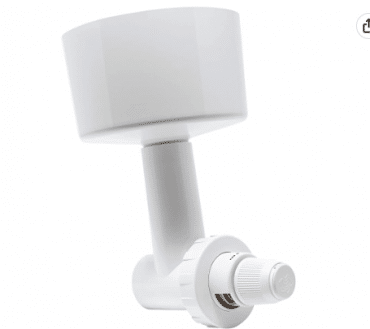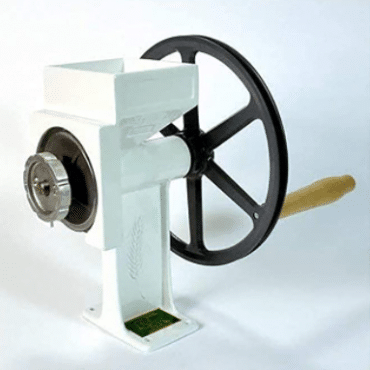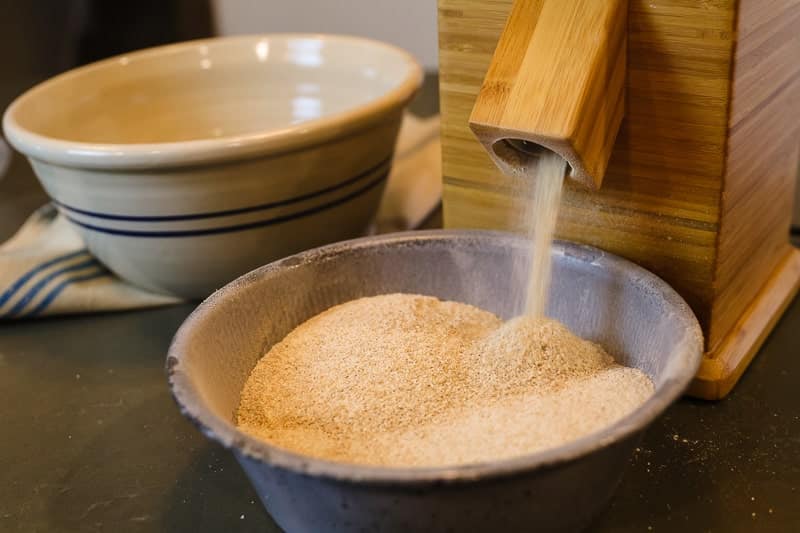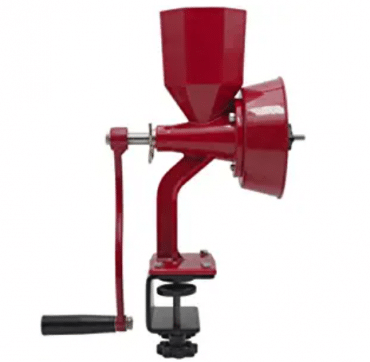Grain mills (also known by the name of wheat grinders) are special devices utilized for producing flour from various kinds of whole grains such as corn or wheat. In this article, we’ll tell you, what exactly is a grain mill, how these devices are classified, what to pay attention to when choosing your own grinder, and lots of other useful facts about it.
Top-5 grain grinders
There are hundreds of various grain grinder models made by different companies. Which of them would we recommend? Here you can see short reviews of five mills that can be rightfully considered ones of the best. All of them are manual grain mills, so they will be very suitable for any prepper.


This manual grain mill has a flywheel, which makes it easy to use. Nevertheless, it’s almost impossible for kids. Another drawback is that its motorization is not easy at all. But for survivalists, it’s a great variant.
WonderMill Junior Deluxe grain mill has a rather small weight, so it seems to be suitable for use in the wild. However, it has to be fastened to a horizontal surface such as a table. Also, it’s very quick and versatile. Its durability is among the highest too. So, it can be surely said that this grinder is one of the best manual mills, especially for survivalists and preppers. You can read more information about WonderMill Junior Deluxe grain mill on this website.


Because it’s a steel burr mill, not a stone one, it’s possible to grind a wide variety of grains in it, including coffee. But it’s suitable only for small grains. It’s not good for very big grains such as corn — yes, it can grind them too, but it’s going to be a bit slow. If your goal is to make flour for cakes, don’t buy this mill — it is just not able to do it. However, in case you are a prepper and want a grinder for baking bread in an emergency situation — it’s completely suitable.
Unfortunately, this grain mill can’t be called very durable. But it’s well compensated with its affordable price.
Grain grinders. The main types
Depending on the type of the milling mechanism, grain mills are divided into burr and impact devices. Let’s learn in a more detailed way about each of them.
Impact grinders, also called micronized, are the most common kind of grain mills. Their popularity, which started approximately at the beginning of the 1990s, is explained by their high level of convenience. They’re powered by electricity, extremely simple to use, and operate very fast.
How does an impact wheat mill function? It has a special milling chamber or a grinding chamber with concentric rings of quickly spinning metal fins. They cut grains into fine flour.

The other type is burr mills. It’s rather slow grinders with two round grinding plates that crush wheat berries or other grains. These plates are named burrs. The lowest burr is fixed, and the top on turns around, crushing grains. There can be stone, cast iron, or stainless steel burrs.
The main advantages of this kind of grain mill are the following:
- They have a more quiet operation than impact mills — they’re noticeably less noisy;
- They have a wide variety of sizes from tiny to really big;
- They can make lots of texture flour types, such as very fine flour, coarser flour, cereal grind, flour with a rougher texture, and cracked grain;
- They grind at a low temperature, which ensures that all the most important nutrients are saved;
- They have both manual and electric variations.
Unfortunately, burr grinders are often more expensive than impact ones.
Should you buy a grain grinder?
Grain grinders are perfect for those who want to make excellent-quality flour and bake delicious bread, cakes, etc. Also, it’s great for preppers, survival enthusiasts, and everybody who stores emergency food supplies. For people who don’t like to spend too much money and prefer to save it, it will also come in handy.
And, on the contrary, in which cases would it be useless to buy such a mill? First, if you aren’t going to utilize it regularly and are not interested in cooking or baking. And secondly, in case you haven’t got enough room to store the grinder itself and grain for it.
Why is a grain mill so necessary?

Many of you probably ask: “Why may I need a wheat grinder? I can see lots of ready-made flour out there in the shops, and it’s possible to just buy and stockpile it!”. Yes, it’s definitely so. This product is a pantry staple, so it’s abundant in shops. But there are still many reasons why purchasing your own grain mill can be necessary. Let’s look at them.
- First of all, the majority of people who’ve eaten anything made of freshly-ground flour say it’s way tastier than store-bought flours. Fresh flour baked goods are definitely much more delicious.
- Whole grains tend to have longer shelf life than any bought flour.
- A wheat grinder can make your diet way more diverse. Store-bought flour is usually made of wheat or probably two or three other cereals. The choice isn’t very wide, is it? Meanwhile, if you grind your own whole grains, you’ll have a much bigger choice — because you can grind literally anything you’d like. Also, you can select the texture of your flour, making it finer or vice versa.
- As with many other food items, to produce flour is far more useful for your health than to consume flour from a store. The nutritional value of bought and DIY flour is drastically different. When you grind your own flour from whole grains, you do not put any chemicals there to make it last longer and look better.
- Also, it’s quite obvious that grinding your own wheat flour is significantly cheaper.
- It will make you more independent of store-bought food.
- The process of making DIY flour in a grain mill can be truly satisfying. If you enjoy cooking, you’ll probably like grinding grains too.
How to choose a good grain mill?
Before purchasing a grain grinder, you’ll need to think about a couple of questions. Firstly, which grain are you going to use, and secondly, will you produce any gluten-free flour? You’ll need to ensure that the selected grinder will be compatible with your preferred type of grain. In case you’re going to grind anything that contains liquid, such as coconuts, chickpeas, or even peanuts, it’s better to prefer a steel grinder to a stone one.
Grain mills can be electric and manual. Electric wheat grinders are way easier to utilize, but a manual grain mill grinds wheat berries without any electricity. So, we think that it’s an optimal variant for survivalists and money savers.
Also, it’s important to mention that the majority of manual grain mills can be motorized rather easily. If you’ve got a powerful enough energy source, you can connect a drill with a battery to the mill. But beware — it can warm up, which is not good for the grain’s health properties. This can be avoided by taking regular pauses. Lots of grain mills can be motorized incredibly easily — for example, those that are made for producing beer. If a grinder is for beer making, it can be rather unfit for producing bread-type flour — it will simply be too coarse. But in case you need cracked grains for a soup, it will definitely make them.
The balance of price and quality is a very important factor too. As a rule, the quality of expensive mills is way better, and their assortment of flour is wider. Mills with the lowest cost out there are models of a manual grinder. They’re rather uncomfortable to use, so if comfort is important to you, you’ll have to choose a more costly mill.
The nutritional value of the flour is also a vital characteristic. If a wheat grinder heats up during its work, many important nutrients will disappear.
Also, if your grain is homegrown, it will need to be hulled beforehand. If it’s bought, it’s usually already hulled, but you’ll also need to check it. The hulling procedure will lengthen all this process, and more importantly, you’ll need completely another device for it.
A typical hand grain mill makes 6 cups of flour in half an hour, which is just right for baking a decent amount of bread. But the exact time may vary. Some models do it a bit faster, while others are noticeably slower, but it’s not instant at all.
How to clean a grain grinder?
It goes without saying that any grain mill needs to be cleaned after grinding and milling flour. But how to clean it? It depends on the type of grains or nuts that you’ve used. If they’re completely dry grains, you’ll need nothing more than an ordinary brush. But in case they’re oily or moist, you’ll have to wash the mill carefully and dry it up.
Frequently Asked Questions — FAQ
Which grain grinder is best?
There are lots of high-quality grain grinders, and which grain mill will be the best for you depends on your purposes. In case you want fine flour for pastries, you’ll need one grinder, and if you need coarse flour — you’ll have to choose another one completely. We would recommend you to look at the grinders that we’ve reviewed in our article.
What are grain grinders used for?
Grain grinders are used to mill various types of grains, such as wheat berries, and make DIY flour from them. Besides this, you can also make some other things, for example, cracked grains for soups.
Can I use a coffee grinder to mill grains?
Theoretically, yes, but a coffee grinder isn’t meant to grind grains, and thus, its mechanism differs. You’ll need to use only limited quantities of grain (approximately 1 cup). Otherwise, you’ll simply jam the device.
How much is a flour mill?
As with most other devices, flour mills have different price categories. Most prices roughly vary from $150 to $ 350, but there can be grinders that cost higher or lower.
How to make a stone flour mill?
There are lots of tutorials on the internet on how to make a DIY mill with stone burrs. We won’t write them here fully, because they are too long, but the main thing we’ll say is that you’ll need two flat and round stone pieces with holes inside. They’ll be the grinding plates. You’ll need to make them rotate, so they’ll crush grains between them.
How do you grind wheat?
You can grind wheat in a device called a grain grinder or flour mill. There are two main types of them: impact electric grain mills and burr mills. They have different mechanisms: impact mills make flour with the help of special stainless steel fins, while burr grinders crush rain between two metal or stone circles.



